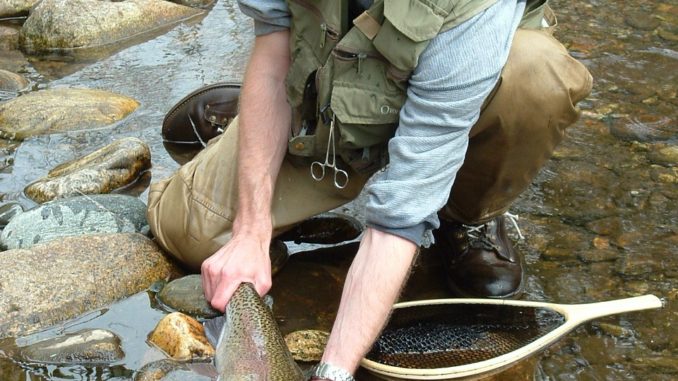
Mostly rainbows and brook trout biting spinners, dry flies and nymphs
While bass fishing has waned somewhat across the state, trout fishing at streams in the northwestern counties of North Carolina continues to be active.
And what Marty Shaffner of Tri-State Angler Service called “that little tropical storm” – Hurricane Sandy – made fishing for trout a little easier, along with the return to catch-and-release-only fishing on “delayed-harvest” streams.
Actually, Sandy had minimal effect at the northwestern corner of the state, mostly contributing high winds that cleared trees and streams of falling leaves.
“It blew all the leaves off mostly, so if you’re wade fishing for trout, you won’t have to worry about getting tangled up too much,” said Shaffner, owner of Tri-State Angler Service (336-957-4630). “In a couple days the trees should be completely bare in Ashe, Surry, Stokes and Wilkes counties – and so will the streams.”
Shaffner said delayed-harvest streams in his area — the Mitchell River, Helton Creek and the East Prong Roaring River in Stone Mountain State Park — are producing rainbows and brook trout for fishermen who use ultralight spinning tackle or fly rods.
The harvest season on delayed-harvest streams closed on Oct. 1, and catch-and-release fishing is required through May 31, 2013. Anglers are restricted to artificial lures with a single hook.
“We’re catching a mixture of rainbows and brook trout,” said Shaffner, whose fish are ranging from 10 to 13 inches, but “we caught one the other day that was 17 inches long,” he said.
Anglers using spinning tackle are tying on various small spinners, including Panther Martins. Fly fishermen are going with blue-winged olives in sizes 22-28 on cloudy days and October Caddis patterns in Sizes 12-14 on sunny days. Fishermen are also nymphing with 22-18 Pheasant Tails, 18-16 Swing Caddis, 18-16 Hare’s Ears, 24-18 Zebra Midges in black or gold, 10-8 egg patterns, 18-14 Princes 24-22 gray RS2s and 12 red or orange Squirmy Wormies.
“I like to use a tandem lure, something like a nymph and a San Juan egg,” Shaffner said.





Be the first to comment